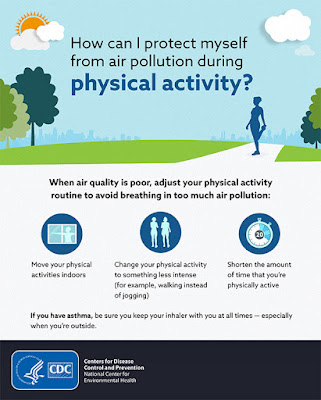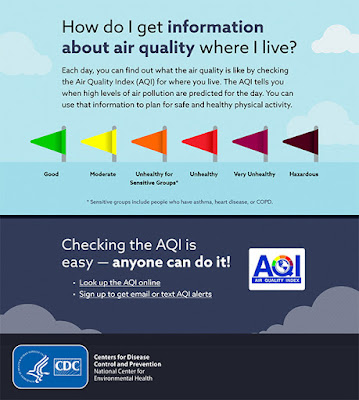National air quality has improved since the early 1990's, but many challenges remain in protecting public health and the environment from air quality problems.
Since the 1950s, air quality has been a major public health and environmental concern. Local, state, and national programs have helped us learn more about the problems and how to solve them.
CDC works closely with the U.S. Environmental Protection Agency to provide air quality data on the tracking network and to better understand how air pollution affects our health. The Tracking Network includes information about the possible health effects of exposure to ozone, particulate matter (PM2.5), benzene, and formaldehyde.
Federal, state, local, and tribal air agencies operate and maintain a wide variety of outdoor air monitoring systems across the United States. Many of these systems serve several environmental purposes. At a basic level, they let us know how clean or polluted the air is, help us track progress in reducing air pollution, and share information with the public about air quality in their communities through the Air Quality Index (AQI). The AQI is a tool to help you quickly learn when air pollution is likely to reach unhealthy levels.
Air pollution in the United States poses a public health threat affecting potentially millions of people throughout the country. It is associated with health problems that include increased emergency department visits and hospitals stays for breathing and heart problems, asthma, and increases in illnesses such as pneumonia and bronchitis.
Tracking air pollution can help people understand how often they are exposed to unhealthy levels of air pollution. Having these data can also help public health professionals or policymakers understand which areas may be most in need of prevention and control activities.
The following image are infographics launched by CDC, about info regarding air and other related info.
Source: CDC
Source: CDC
Source: CDC
Source: CDC
Air pollution can make it harder for people with asthma and other respiratory (breathing) diseases to breathe. If you want to know more about public health issues regarding respiratory health, you could check out here.
AIR POLLUTANS
EPA Criteria Pollutants
The EPA has identified six pollutants as "criteria" air pollutants because it regulates them by developing human health-based and/or environmentally-based criteria (science-based guidelines) for setting permissible levels. These six pollutants are carbon monoxide, lead, nitrogen oxides, ground-level ozone, particle pollution (often referred to as particulate matter), and sulfur oxides.
The EPA has identified six pollutants as "criteria" air pollutants because it regulates them by developing human health-based and/or environmentally-based criteria (science-based guidelines) for setting permissible levels. These six pollutants are carbon monoxide, lead, nitrogen oxides, ground-level ozone, particle pollution (often referred to as particulate matter), and sulfur oxides.
Particle Pollution
Particle pollution — also called particulate matter (PM) — is made up
of particles (tiny pieces) of solids or liquids that are in the air.
These particles may include:- Dust
- Dirt
- Soot
- Smoke
- Drops of liquid
Source: CDC
Particle pollution can come from two different kinds of sources — primary or secondary. Primary sources cause particle pollution on their own. For example, wood stoves and forest fires are primary sources.
Secondary sources let off gases that can form particles. Power plants and coal fires are examples of secondary sources. Some other common sources of particle pollution can be either primary or secondary — for example, factories, cars and trucks, and construction sites.
Smoke from fires and emissions (releases) from power plants, industrial facilities, and cars and trucks contain PM2.5.
Particle Pollution and Your Health
Breathing in particle pollution can be harmful to your health. Coarse (bigger) particles, called PM10, can irritate your eyes, nose, and throat. Dust from roads, farms, dry riverbeds, construction sites, and mines are types of PM10.
Fine (smaller) particles, called PM2.5, are more dangerous because they can get into the deep parts of your lungs — or even into your blood.
How can particle pollution effect my health?
Particle pollution can affect anyone, but it bothers some people more than others. People most likely to experience health effects caused by particle pollution include:
- People with heart or lung diseases (for example, asthma)
- Older adults
- Babies and children
Particle pollution has also been linked to:
- Eye irritation
- Lung and throat irritation
- Trouble breathing
- Lung cancer
- Problems with babies at birth (for example, low birth weight)
You could read more about PM impacts on health here.
Ground Level Ozone
Ground level or "bad" ozone is not emitted directly into the air, but is created by chemical reactions between oxides of nitrogen (NOx) and volatile organic compounds (VOC) in the presence of sunlight. Emissions from industrial facilities and electric utilities, motor vehicle exhaust, gasoline vapors, and chemical solvents are some of the major sources of NOx and VOC.
Breathing ozone can trigger a variety of health problems, particularly for children, the elderly, and people of all ages who have lung diseases such as asthma. Ground level ozone can also have harmful effects on sensitive vegetation and ecosystems.
Your exposure to ozone depends mainly on where you live and work and how much time you spend outside. Everyone can have health problems from ozone. Symptoms might be very mild or more serious. People with lung disease, children, older adults, and people who are active outdoors are at the highest risk of having problems when ozone levels are unhealthy.
Many scientific studies have linked ground-level ozone contact to varied problems, such as
- lung and throat irritation,
- wheezing and breathing difficulties during exercise or outdoor activities,
- coughing and pain when taking a deep breath,
- aggravation of asthma, bronchitis, and emphysema, and
- higher chance of getting respiratory illness like pneumonia or bronchitis.
You could check CDC page here for more and further information about other air pollutans.
Show How You Care about the Air - take action each day to reduce your contribution to air pollution. Here are a few suggestions:
- Limit driving and idling; car pool, combine errands, use public transportation, bike, or walk.
- Turn out lights when you’re not using them.
- Set your thermostat a little higher when the weather gets warm.
- Refuel your vehicle early morning or after dusk.
- Avoid the drive-thru and go inside to order your food.
You could check here if you want to find a variety of helpful resources about air quality for public health professionals — including research, data, tools for tracking the health impact of air pollution, and more.
If you want to learn more about air quality, visit Tracking Air Quality.
Sources:
CDC-Outdoor Air-Air and Health
CDC-Outdoor Air-Air Quality
CDC-Air
EPA & CDC - Air Quality Awareness Week
CDC-Infographics
CDC-Public Health Issues-Respiratory Health
CDC-Particle Pollution
EPA-Ozone Pollution





Thanks for sharing such beautiful information with us. I hope you will share some more information about vaccinations.Alhanan home health care centre, they offer various home care services in Dubai, we just need to call them and book the service we require. They have a team of highly trained, qualified and licensed doctor, nurses and physiotherapist. Check out them online to find more about them.
ReplyDelete